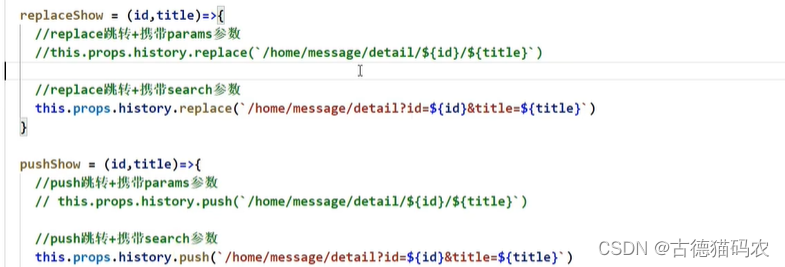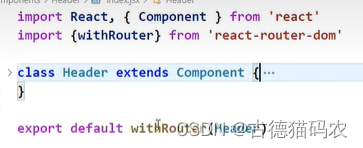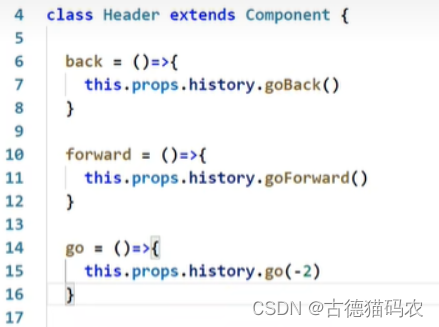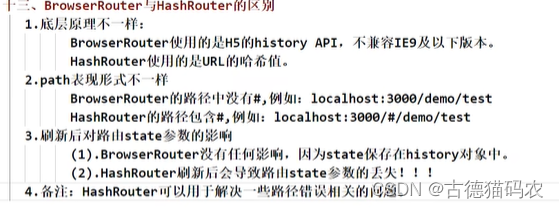1、函数式组件
在vite脚手架中执行:
app.jsx:
import { useState } from 'react' import reactLogo from './assets/react.svg' import viteLogo from '/vite.svg' import './App.css' function App() { console.log(this) return <h2>我是函数式组件</h2> } export default App main.tsx:
import React from 'react' import ReactDOM from 'react-dom/client' import App from './App.tsx' import './index.css' ReactDOM.createRoot(document.getElementById('root')!).render( <React.StrictMode> <App /> </React.StrictMode>, ) 注意:
1、这里没有this,因为babel编译后开启了模式
2、渲染的组件必须要大写开头(虚拟dom转为真实的dom)
2、类式组件
1、类式组件必须通过react的Component继承
2、组件必须在类中的render方法中返回
import { Component } from "react" //使用类组件的时候必须要继承react中的Component //类组件不写构造器,必须要render //render放在组件的原型对象上 //this是指向组件实例对象, class MyClassCom extends Component { render() { return( <div> <h1>This is Class Component</h1> </div> ) } } export {MyClassCom}3、组件三大核心(都是在类组件中使用,props可以在函数组件中使用)
3.1、state
import { Component } from "react"; //使用类组件的时候必须要继承react中的Component //类组件可以不写构造器,必须要render //render放在组件的原型对象上 //this是指向组件实例对象, class MyClassCom extends Component { //构造器调用一次 constructor(props) { super(props); //初始化状态 this.state = { name: "张三", isHot: false, }; //绑定this,这里其实是重写的,可以用其他名字,但是下面调用也要改名字 this.b = this.b.bind(this); } //调用1+n次,n次是响应式状态更新的次数 render() { return ( <div> <h1>今天{this.state.isHot ? "炎热" : "凉快"}</h1> <button onClick={this.a}>点击</button> <button onClick={this.b}>点击</button> </div> ); } a = () => { //这里能拿到this,是因为箭头函数绑定了this console.log(this); //修改状态,必须通过setState修改状态 this.setState({ isHot: !this.state.isHot, }); }; b() { //因为是直接调用的类方法,不是实例对象调用的,所以拿不到this //类中的方法默认开启了局部严格模式,所以this指向undefined console.log(this); this.setState({ isHot: !this.state.isHot, }); } } export { MyClassCom }; 简写方式:
import { Component } from "react"; class MyClassCom extends Component { //类中可以直接定义属性 state = { name: "张三", isHot: false, }; render() { return ( <div> <h1>今天{this.state.isHot ? "炎热" : "凉快"}</h1> <button onClick={this.a}>点击</button> </div> ); } //直接使用箭头函数(箭头函数可以修改this指向),避免了this指向修改,也就不用构造器了 a = () => { this.setState({ isHot: !this.state.isHot, }); }; } export { MyClassCom };总结:
1、state是组件对象的重要属性,值是对象
2、组件被称为”状态机”,通过更新组件的state来更新对应页面显示(重新渲染页面-可以理解为响应式)
3、组件中的render方法中的this为组件实例对象
4、组件自定义方法中的this为undefined(通过强制绑定this,通过对象的build(),如果是类组件但是要使用构造器,也可以直接使用箭头函数(推荐直接使用箭头函数))
5、状态数据不能直接修改或者更新,要通过setState修改更新
3.2、props
3.2.1、基本使用
封装组件:
import { Component } from "react"; class Person extends Component<{ name: string,age:string,sex:string }> { render() { const {name, age , sex} = this.props; return ( <ul> <li>{name}</li> <li>{age}</li> <li>{sex}</li> </ul> ) } } export { Person }调用组件(通过props传值)
import { Person } from './components/propsReact' function App() { //return <h2>我是函数式组件<MyClassCom></MyClassCom></h2> return ( <div> <Person name="张三" age="18" sex="男"></Person> <Person name="李四" age="19" sex="女"></Person> </div> ) } export default App其实这里就是一个父传子的操作,跟vue思想差不多
3.2.2、props限制
类型限制:
import { Component } from "react"; import PropTypes from "prop-types";//需要安装库 class Person extends Component<{ name: string,age:string,sex:string }> { render() { const {name, age , sex} = this.props; return ( <ul> <li>{name}</li> <li>{age}</li> <li>{sex}</li> </ul> ) } } Person.propTypes = { name: PropTypes.string.isRequired,//isRequired是必填项 age: PropTypes.string.isRequired, sex: PropTypes.string.isRequired, }; export { Person }import { Person } from './components/propsReact' function App() { //return <h2>我是函数式组件<MyClassCom></MyClassCom></h2> return ( <div> <Person name="asd" age="18" sex="男"></Person> <Person name="李四" age="19" sex="女"></Person> </div> ) } export default App简写方式:
import { Component } from "react"; import PropTypes from "prop-types"; class Person extends Component<{ name: string; age: string; sex: string }> { static propTypes = { name: PropTypes.string.isRequired, age: PropTypes.string.isRequired, sex: PropTypes.string.isRequired, }; static defaultProps = { name: "张三", age: "18", sex: "男", }; render() { const { name, age, sex } = this.props; return ( <ul> <li>{name}</li> <li>{age}</li> <li>{sex}</li> </ul> ); } } export { Person }; 3.2.3、函数组件使用props
函数式组件只能使用props,其他两个属性没法用
import { Component } from "react"; import PropTypes from "prop-types"; class Person extends Component<{ name: string; age: string; sex: string }> { static propTypes = { name: PropTypes.string.isRequired, age: PropTypes.string.isRequired, sex: PropTypes.string.isRequired, }; static defaultProps = { name: "张三", age: "18", sex: "男", }; render() { const { name, age, sex } = this.props; return ( <ul> <li>{name}</li> <li>{age}</li> <li>{sex}</li> </ul> ); } } function Person1(props: { name: string; age: string; sex: string }) { const { name, age, sex } = props; return ( <ul> <li>{name}</li> <li>{age}</li> <li>{sex}</li> </ul> ); } Person1.prototype = { name: PropTypes.string.isRequired, age: PropTypes.string.isRequired, sex: PropTypes.string.isRequired, } export { Person, Person1}; import { Person,Person1 } from './components/propsReact' function App() { //return <h2>我是函数式组件<MyClassCom></MyClassCom></h2> return ( <div> <Person name="张三" age="18" sex="男"></Person> <Person name="李四" age="19" sex="女"></Person> <Person></Person> <Person1 name="张三" age="108" sex="男"></Person1> </div> ) } export default App 总结:
1、每个组件都有props属性
2、组件所有的标签属性都会存在props中
3、组件内部不要修改props
4、通过标签属性从组件外部传递到内部的变化的数据
3.3、refs
3.3.1、字符串类型写法:
存在效率问题(不推荐使用)
import React from "react"; class RefsDemo extends React.Component{ showData = () => { console.log(this) const {input1} = this.refs alert(input1.value) } showData2 = () => { const {input2} = this.refs alert(input2.value) } render(): React.ReactNode { return ( <div> <input ref="input1" type="text" /> <button onClick={this.showData}></button> <input ref="input2" onBlur={this.showData2} type="text" /> </div> ) } } export default RefsDemo3.3.2、回调函数形式
import React from "react"; class RefsDemo extends React.Component{ showData = () => { console.log(this) const {input1} = this alert(input1.value) } showData2 = () => { const {input2} = this alert(input2.value) } render(): React.ReactNode { return ( <div> <input ref={c=>this.input1=c} type="text" /> <button onClick={this.showData}></button> <input ref={c=>this.input2=c} onBlur={this.showData2} type="text" /> </div> ) } } export default RefsDemo注意:
1、这样写会有 副作用
2、可以把方法抽出来放在render里面作为方法调用
3.3.3、React.createRef()钩子的使用
import React from "react"; class RefsDemo extends React.Component{ /**每一个createRef都是单独的,用来获取组件中的元素 */ myRef = React.createRef() myRef1 = React.createRef() showData = () => { console.log(this.myRef.current.value) } showData2 = () => { console.log(this.myRef1.current.value) } render(): React.ReactNode { return ( <div> <input ref={this.myRef} type="text" /> <button onClick={this.showData}></button> <input ref = {this.myRef1} onBlur={this.showData2} type="text" /> </div> ) } } export default RefsDemo总结ref:
1、尽可能避免字符串方法的使用
2、内联用的最多,第三个比较繁琐,要使用钩子
4、事件处理
4.1、非受控组件
import React from "react"; class Login extends React.Component { handleSubmit = (e) => { e.preventDefault()//阻止默认行为 const { username, password } = this console.log(username, password) alert(`用户名:${username.value} 密码:${password.value}`) } render(): React.ReactNode { return ( <div> <form action="https://www.baidu.com" onSubmit={this.handleSubmit}> 用户名:<input ref={c=>this.username = c} type="text" name="username" /> 密码:<input ref = {c=>this.password = c} type="password" name="password" /> <button type="submit">登录</button> </form> </div> ) } } export default Login;4.2、受控组件
import React from "react"; class Login extends React.Component { state: Readonly<{}> = { username: "", password: "" } saveUsername = (e) =>{ this.setState({ username: e.target.value }) } savePassword = (e) =>{ this.setState({ password: e.target.value }) } handleSubmit = (e) => { e.preventDefault()//阻止默认行为 const { username, password } = this.state console.log(username, password) alert(`用户名:${username} 密码:${password}`) } render(): React.ReactNode { return ( <div> <form action="https://www.baidu.com" onSubmit={this.handleSubmit}> 用户名:<input onChange={this.saveUsername} type="text" name="username" /> 密码:<input onChange={this.savePassword} type="password" name="password" /> <button type="submit">登录</button> </form> </div> ) } } export default Login;注意:
1、受控组件能够避免ref的使用
2、现用现取是非受控,维护状态的是受控组件
5、高阶函数+函数柯里化
高级函数:
1、若A函数,按接的参数是一个函数,那么A就是高阶函数
2、若A函数,调用的返回值依然是一个函数,那么A就可以称为高阶函数
常见的高阶函数:Promise、setTimeout、arr.map()等
函数的柯里化:通过函数调用继续返回函数的方式,实现多次接收参数最后统一处理的函数
eg:
import React from "react"; class Login extends React.Component { saveFromData = (typename) =>{ return (event) => { this.setState({ [typename]: event.target.value }) } } render(): React.ReactNode { return ( <div> 用户名:<input onChange={this.saveFromData('username')} type="text" name="username" /> 密码:<input onChange={this.saveFromData('password')} type="password" name="password" /> <button type="submit">登录</button> </div> ) } } export default Login;6、生命周期
组件挂载完毕和将要卸载的调用:
import React from "react"; class Login extends React.Component { // 组件挂载的时候调用 componentDidMount(): void { this.timer = setTimeout(() => { console.log(11111) }, 1000) } // 挂载的组件卸载前 的调用 componentWillUnmount(): void { clearTimeout(this.timer) } render(): React.ReactNode { return ( <div> </div> ) } } export default Login;6.1、组件挂载流程
6.1.1、生命周期(旧)

eg:
import { Component } from "react"; class Count extends Component { constructor(props) { super(props); this.state = { count: 0, }; this.name = "count"; console.log("count-constructor"); } add = () => { this.setState({ count: this.state.count + 1, }); }; foce = () => { this.forceUpdate(); }; // 组件将要挂载的钩子 componentWillMount() { console.log("componentWillMount"); } // 组件挂载完成的钩子 componentDidMount() { console.log("componentDidMount"); } // 组件将要卸载 componentWillUnmount() { console.log("componentWillUnmount"); } // 组件是否需要更新--阀门 showldComponentUpdate() { console.log("showldComponentUpdate"); return true; } // 组件将要更新 componentWillUpdate() { console.log("componentWillUpdate"); } // 组件更新完成 componentDidUpdate() { console.log("componentDidUpdate"); } render() { return ( <div> <h2>当前求和为:{this.state.count}</h2> <button onClick={this.add}>点我+1</button> <button onClick={this.foce}>强制更新组件</button> <A name={this.name} content={this.state.count} /> </div> ); } } class A extends Component { //这个钩子比较奇特,只有操作更新的时候才会调用,第一次传的时候不调用,此处就是操作+1的时候才调用--将要废弃 componentWillReceiveProps(props) { console.log("componentWillReceiveProps",props); } render() { return ( <div> 我是子组件{this.props.name} <p>{this.props.content}</p> </div> ); } } export default Count; 总结:(标红的是常用的)
1.初始化阶段:由ReactDoM.render()触发---初次渲染
A、constructor()
B、componentWillMount() //将要废弃
C、render()
D、componentDidMount() ---常用于做初始化数据(一般用于网络请求、订阅消息、开启定时器)
2.更新阶段:由组件内部this.setsate()或父组件render触发
A、shouldComponentUpdate()
B、componentWillUpdate() //将要废弃
C、render()
D、componentDidUpdate()
3.卸线组件:由ReactD0M.unmountComponentAtNode()触发
A、componentWillUnmount() --常用于收尾(关闭定时器、取消订阅等)
6.1.2、生命周期(新>=16.4)
官网的周期图:

eg:
import { Component, createRef } from "react"; class Count extends Component { constructor(props) { super(props); this.state = { count: 0, }; this.name = "count"; console.log("count-constructor"); } add = () => { this.setState({ count: this.state.count + 1, }); }; foce = () => { this.forceUpdate(); }; //若state的值在任何时候取决于props的值,则使用getDerivedStateFromProps ---使用场景及其罕见 // static getDerivedStateFromProps(props,state) { // console.log("getDeruvedStateFromProps"); // // return console.log(props,state); // } // 组件挂载完成的钩子 componentDidMount() { console.log("componentDidMount"); } // 组件将要卸载 componentWillUnmount() { console.log("componentWillUnmount"); } // 组件是否需要更新--阀门 showldComponentUpdate() { console.log("showldComponentUpdate"); return true; } // 组件更新前获取快照 getSnapshotBeforeUpdate() { console.log("getSnapshotBeforeUpdate"); return null } // 组件更新完成 componentDidUpdate(preProps, preState,Shouwkong) { console.log("componentDidUpdate",preProps,preState,Shouwkong); } render() { return ( <div> <h2>当前求和为:{this.state.count}</h2> <button onClick={this.add}>点我+1</button> <DomList /> </div> ); } } export default Count; /** * 列表滚动渲染案例 */ class DomList extends Component { constructor(props) { super(props); this.listRef = createRef(); this.state = { newsArr: [], }; } componentDidMount() { setInterval(() => { const { newsArr } = this.state; const news = '商品' + (newsArr.length + 1); this.setState({ newsArr: [news, ...newsArr], }); }, 1000); } getSnapshotBeforeUpdate(prevProps, prevState) { return this.listRef.current ? this.listRef.current.scrollHeight : null; } componentDidUpdate(prevProps, prevState, snapshot) { if (this.listRef.current) { this.listRef.current.scrollTop += this.listRef.current.scrollHeight - snapshot; } } render() { return ( <div className="list" ref={this.listRef} style={{ height: '300px', overflow: 'auto' }}> {this.state.newsArr.map((item, index) => ( <p key={index} className="news">{item}</p> ))} </div> ); } } 总结:
(标红的是常用的)
1.初始化阶段:由ReactDoM.render()触发---初次渲染
A、constructor()
B、getDerivedStateFromProps
C、render()
D、componentDidMount() ---常用于做初始化数据(一般用于网络请求、订阅消息、开启定时器)
2.更新阶段:由组件内部this.setsate()或父组件render触发
A、getDerivedStateFromProps
B、showldComponentUpdate
C、render()
D、getSnapshotBeforeUpdate
E、componentDidUpdate
3.卸线组件:由ReactD0M.unmountComponentAtNode()触发
A、componentWillUnmount() --常用于收尾(关闭定时器、取消订阅等)
7、diffing算法


8、脚手架配置
8.1、代理配置
方法1:
在package.json追加如下配置:
"proxy":"http://localhost:5000"说明:
1、优点:配置简单,前端请求资源时可以不加任何前缀
2、缺点:不能配置多个代理
3、工作方式:当请求3000不存在的时候,资源请求转发给5000
方法2:
1、第一步:创建代理配置文件
在src下创建配置配置文件:src/setupProxy.js
2、编写setupProxy.js配置具体代理规则:
const proxy = require('http-proxy-middleware'); module.exports = function (app) { app.use(proxy('/api', { //api是需要转发的请求(所有带有/api标识的请求都会转发给后台-5000) target: 'http://localhost:3000' , //配置转发目标地址(能返回苏剧的服务器地址) changeOrigin: true,//控制服务器接收请求头中Host字段的值, /** * 重写请求路径 * 例如: * 请求地址:http://localhost:3000/api/user/list * 重写之后:http://localhost:5000/user/list */ pathRewrite: { '^/api': ''//去除请求地址中的/api,保证能正常请求到接口 }, } )); };说明:
1、优点:可以配置多个代理,可以灵活的控制请求是否走代理
2、配置繁琐,前端请求资源时必须加前缀
9、消息订阅-发布机制
1、工具库:PubSubJS
2、npm install pubsub-js
3、使用:
3.1、improt PubSub from 'pubsub-js'
3.2、PubSub.subscribe("del"mfunction(data){})//订阅
3.3、PubSub.publish(‘del’,data)//发布消息
eg:
父组件: import React, { Component } from 'react' import A from "../components/A" import B from "../components/B" export default class test extends Component { render() { return ( <div> <A/> <B/> </div> ) } } A子组件--发布 import React, { Component } from 'react' import pubsub from 'pubsub-js' export default class A extends Component { componentDidMount(){ pubsub.publish('test', 'test') } render() { return ( <div>A</div> ) } } B子组件--订阅 import React, { Component } from 'react' import pubsub from 'pubsub-js' export default class B extends Component { componentDidMount() { pubsub.subscribe('test',(msg,data)=>{ console.log(msg,data) }) } componentWillUnmount() { pubsub.unsubscribe('test') } render() { return ( <div>B</div> ) } } 10、路由(参考另外一个18+的教程)
参考链接:Home v6.24.0 | React Router
对比:


基本使用的三种方式:(16)



11、编程式导航
方法调用:

通过onclick调用:

detail组件接收:

12、withRouter的使用




13、BrowserRouter与HashRouter区别

